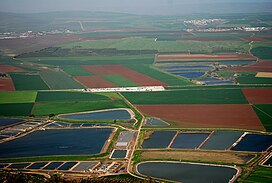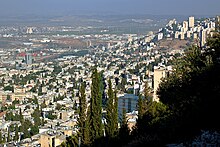Jezreel Valley
| Jezreel Valley | |
|---|---|
 Agriculture in the Jezreel Valley | |
 | |
| Geography | |
| Location | Israel |
| Coordinates | 32°35′47″N 35°14′31″E / 32.59639°N 35.24194°E |
The Jezreel Valley (from the
Name


The Jezreel Valley takes its name from the ancient city of
The Arabic name of the valley is Marj Bani Amir (
Geology

The valley once acted as the channel by which the
Geography
The Jezreel Valley is a green fertile plain covered with fields of wheat, watermelon, melon, oranges, white beans, cowpeas, chickpeas, green beans, cotton,
Biblical and theological relevance
In the Hebrew Bible
According to the
According to 2 Kings 9:1–9:10, the Jezreel Valley was where Jehu massacred all members of the Omride family.
In Christian eschatology
In
History
The valley formed an easier route through Israel than crossing the mountains on either side, and so saw a large amount of traffic, and was the site of many historic battles
Archaeological excavations have indicated near continuous settlement from the
Bronze and Iron Ages

Biblical cities in the Jezreel Valley include Jezreel, Megiddo, Beit She'an, Shimron and Afula.[8]
There is a surviving detailed account of the earliest battle for the Jezreel Valley, the 15th-century BC
In the western part of the Jezreel Valley, 23 of the 26 Iron Age I sites (12th to 10th centuries BCE) yielded typical
Roman period
In the late Second Temple period, Josephus refers to both the Jezreel Valley and the Beit Netofa Valley as the "Great Plain".[10]
Mamluk period
During the
Ottoman period
During the early
In the late Ottoman era, the outskirts of the Jezreel Valley, within both the Nazareth and Shefa-'Amr nahiyas, had sparse populations. Malaria was widespread, particularly in the plains, notably in the vicinity of the Kishon River and its tributaries. This disease drove away many locals, allowing Bedouins to fill the void. In drought years, Bedouins from the ghor even encroached into lands cultivated by the fellahin, covering the area with their tents. The "permanent" nomads, Bedouins of Turkmen descent, resided in the Jezreel Valley during summer and autumn, then wintered between the Sharon region and the Valley, moving through the Manasseh Hills.[12]

In the 1870s, the
Between 1912 and 1925 the Sursock family (then under the
British Mandate
After the land was sold to the American Zion Commonwealth, some of the Arab farmers who lived in nearby villages and had been working for the absentee landowners were given financial compensation or were provided with land elsewhere.[17] Despite the sale, some of the farmers refused to leave their land, as in Afula (El-Ful),[18] however the new owners decided that it would be inappropriate for these farmers to remain as tenants on land intended for Jewish labor. This was a commonplace feeling among segments of the Jewish population, part of a socialist ideology of the Yishuv, which included their working the land rather than being absentee landowners. British police had to be used to expel some and the dispossessed made their way to the coast to search for new work with most ending up in shanty towns on the edges of Jaffa and Haifa.[19]

Following the purchase of the land, the Jewish farmers created the first modern-day settlements, founded the modern day city of Afula and drained the swamps to enable further land development of areas that had been uninhabitable for centuries. The first moshav, Nahalal, was settled in this valley on 11 September 1921.
After the widespread
State of Israel
In 2006, the Israeli Transportation Ministry and Jezreel Valley Regional Council announced plans to build an international airport near Megiddo but the project was shelved due to environmental objections.[21]
Archaeological excavations
Archaeological sites in the Jezreel Valley are currently excavated and coordinated by the Jezreel Valley Regional Project.[22]
In 2021, archaeologist from
Archaeological sites
See also
- Mamluks.
- Dead Sea
- Jezreel Valley Regional Council
References
- ^ Frank Jacobs (23 July 2010). "187 - A Map of the Apocalypse". Big Think. Retrieved 27 March 2019.
- ^ "Getting Blown Away at Armageddon". Leaderworks. 28 October 2018. Archived from the original on 23 October 2018. Retrieved 27 March 2019.
- ^ Immanuel Benzinger, Esdraelon 2. In: Paulys Realencyclopädie der classischen Altertumswissenschaft (RE). Band VI, 1, Stuttgart 1907, cc625-626.
- Encyclopedia Biblica
- ^ ISBN 978-90-04-08112-3.
- ^ Fund, Palestine Exploration (1838). The Survey of Western Palestine: A General Index to 1. The Memoirs, Vols. I.-III.; 2. The Special Papers; 3. The Jerusalem Volume; 4. The Flora and Fauna of Palestine; 5. The Geological Survey; and to The Arabic and English Name Lists. Committee of the Palestine Exploration Fund. p. 127.
- ^ Eric H. Cline, Assistant Director US, Tel Megiddo Expedition
- ^ ISBN 978-0-658-00368-4
- S2CID 163635296.
- Vita§, 41, et al.)
- ^ S2CID 258602184.
- ISBN 978-965-493-184-7.
- ISBN 978-965-07-0797-2
- ^ Abu-Lughod, Ibrahim (1971). (Ed)., The Transformation of Palestine. Illinois: Northwestern Press, p. 126.
- ^ a b Safarix.com Archived 11 February 2007 at the Wayback Machine, pg. 49
- ISBN 978-965-493-184-7.
- ^ Arieh L. Avneri, The Claim of Dispossession Jewish Land-Settlement and the Arabs 1878-1948 (New Brunswick (USA) and London, 1984), 117–130.
- ^ "Buying the Emek by Arthur Ruppin, 1929 (with an introduction)". Zionism-israel.com. Retrieved 24 March 2013.
- ^
- Nevill Barbour: Nisi Dominus: A Survey of the Palestine Controversy. George G. Harrap, London 1946, pp. 117–118
- Polk, Stamler, Asfour: Backdrop to Tragedy: The Struggle for Palestine. Beacon Press, Boston, 1957, pp. 237–238.
- ^ Palestine. Report on Immigration, Land Settlement and Development. By Sir John Hope Simpson, C.I.E. Archived 22 September 2008 at the Wayback Machine
- Chapter 1.3: Palestine: The Country and the Climate; 3)The vale of Esdraelon,
- Chapter 5.3: Jewish Settlement on the Land; 3)The effect of Jewish settlement on the Arab
- ^ "Satellite News and latest stories | The Jerusalem Post". fr.jpost.com.
- ^ "Home". jezreelvalleyregionalproject.com. Retrieved 19 January 2015.
- ^ Ancient inscription dedicated to Jesus son of Mary discovered in the Jezreel Valley
- ^ "Ancient 'Christ, born of Mary' inscription unearthed in northern Israel". The Jerusalem Post | JPost.com. 20 January 2021. Retrieved 11 February 2021.
- ^ "Inscription to Jesus, dedicated by the 'miserable Thomas', found in Northern Israel". Haaretz. Retrieved 11 February 2021.
- ^ "Israeli Archaeologists Find 1,500-Year-Old Christian Inscription | Archaeology | Sci-News.com". Breaking Science News | Sci-News.com. 25 January 2021. Retrieved 11 February 2021.
- ^ Geggel, Laura (22 January 2021). "1,500-year-old 'Christ, born of Mary' inscription discovered in Israel". livescience.com. Retrieved 11 February 2021.
External links
- Jezreel Valley Regional Project
- Chisholm, Hugh, ed. (1911). . Encyclopædia Britannica (11th ed.). Cambridge University Press.
- Geography of Israel: The Jezreel Valley on the Jewish Virtual Library
- The Jezreel Valley Museum

